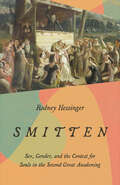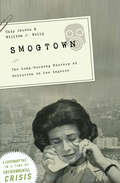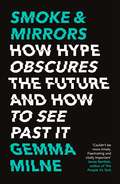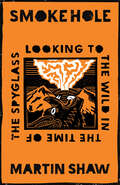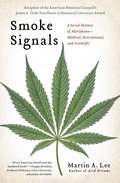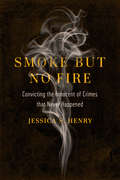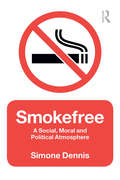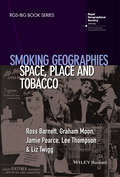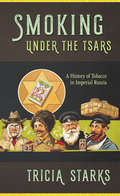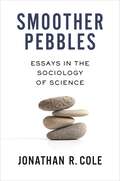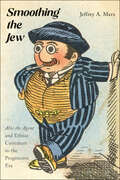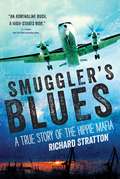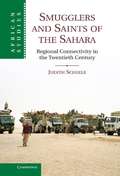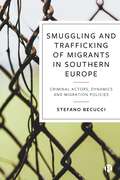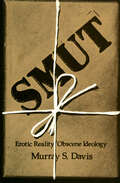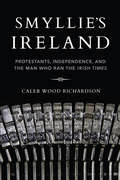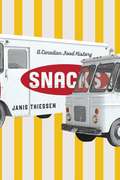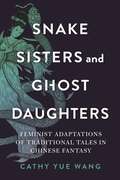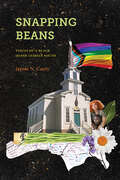- Table View
- List View
Smitten: Sex, Gender, and the Contest for Souls in the Second Great Awakening
by Rodney HessingerIn Smitten, Rodney Hessinger examines how the Second Great Awakening disrupted gender norms across a breadth of denominations. The displacement and internal migration of Americans created ripe conditions for religious competition in the North. Hessinger argues that during this time of religious ferment, religious seekers could, in turn, play the missionary or the convert. The dynamic of religious rivalry inexorably led toward sexual and gender disruption. Contending within an increasingly democratic religious marketplace, preachers had to court converts in order to flourish. They won followers through charismatic allure and making concessions to the desires of the people. Opening their own hearts to new religious impulses, some religious visionaries offered up radical dispensations—including new visions of how God wanted them to reorder sex and gender relations in society. A wide array of churches, including Methodists, Baptists, Mormons, Shakers, Catholics, and Perfectionists, joined the fray. Religious contention and innovation ultimately produced backlash. Charges of seduction and gender trouble ignited fights within, among, and against churches. Religious opponents insisted that the newly converted were smitten with preachers, rather than choosing churches based on reason and scripture. Such criticisms coalesced into a broader pan-Protestant rejection of religious enthusiasm. Smitten reveals the sexual disruptions and subsequent domestication of religion during the Second Great Awakening.
Smogtown: The Lung-Burning History of Pollution in Los Angeles
by Chip Jacobs William J. Kelly“A zany and provocative cultural history” of LA’s infamous air pollution and the struggle to combat it from the 1940s to today (Kirkus).The smog beast wafted into downtown Los Angeles on July 26, 1943. Nobody knew what it was. Secretaries rubbed their eyes. Traffic cops seemed to disappear in the mysterious haze. Were Japanese saboteurs responsible? A reckless factory? The truth was much worse—it came from within, from Southern California’s burgeoning car-addicted, suburban lifestyle. Smogtown is the story of pollution, progress, and how an optimistic people confronted the epic struggle against airborne poisons barraging their hometowns. There are scofflaws and dirty deals aplenty, plus murders, suicides, and an ever-present paranoia about mass disaster. California based journalists Chip Jacobs and William J. Kelly highlight the bold personalities involved, the corporate-tainted science, the terrifying health costs, the attempts at cleanup, and how the smog battle helped mold the modern-day culture of Los Angeles.
Smoke & Mirrors: How Hype Obscures the Future and How to See Past It
by Gemma Milne'Stop following the news until you've read Gemma Milne's persuasive analysis of the hype and bullshit that distort our understanding of emerging science. As she shows, the starting point to grasping the genuine opportunities of AI, life sciences and climate tech is a healthy dose of critical thinking'David Rowan, founding editor of WIRED UK and author of Non-Bullshit Innovation: Radical Ideas from the World's Smartest Minds'Couldn't be more timely. Fascinating and vitally important'Jamie Bartlett, author of The People Vs Tech'A much-needed blast of fresh air! Gemma Milne expertly shows us how to separate the truth from the hype surrounding the emerging techs of today, and those of the near-tomorrow'Lewis Dartnell, author of Origins: How the Earth Made Us'I loved this book! This is exactly the sort of sceptical, cut-through-the crap-but-still-excited-about-what's-emerging book around tech innovation that's sorely needed, yet is so hard to find . . . essential reading for anyone who's serious about how real-world advances might be effectively harnessed to build a better future'Dr Andrew Maynard, scientist and author of Films from the Future and Future Rising'[A] vital contribution in a world where technological progress promises so much, but too often disappoints. If, like me, you believe that advances in science and technology are our best hope for solving the grand challenges of our times, this book is the indispensable guide to avoiding the mirages and the charlatans along the way'Matt Clifford, co-founder and CEO of Entrepreneur First'A refreshingly grown-up, clear-headed look at the interaction between science, technology and the media - readable without being dumbed down, acknowledging complexities without being heavy'Tom Chivers, author of The AI Does Not Hate You'ROBOTS WILL STEAL YOUR JOB!''AI WILL REVOLUTIONISE FARMING!''GENETIC EDITING WILL CURE CANCER!'Bombastic headlines about science and technology are nothing new. To cut through the constant stream of information and misinformation on social media, or grab the attention of investors, or convince governments to take notice, strident headlines or bold claims seem necessary to give complex, nuanced information some wow factor.But hype has a dark side, too.It can mislead. It can distract. It can blinker us from seeing what is actually going on.From AI, quantum computing and brain implants, to cancer drugs, future foods and fusion energy, science and technology journalist Gemma Milne reveals hype to be responsible for fundamentally misdirecting or even derailing crucial progress.Hype can be combated and discounted, though, if you're able to see exactly where, how and why it is being deployed.This book is your guide to doing just that.
Smoke & Mirrors: How Hype Obscures the Future and How to See Past It
by Gemma Milne'Stop following the news until you've read Gemma Milne's persuasive analysis of the hype and bullshit that distort our understanding of emerging science. As she shows, the starting point to grasping the genuine opportunities of AI, life sciences and climate tech is a healthy dose of critical thinking'David Rowan, founding editor of WIRED UK and author of Non-Bullshit Innovation: Radical Ideas from the World's Smartest Minds'Couldn't be more timely. Fascinating and vitally important'Jamie Bartlett, author of The People Vs Tech'A much-needed blast of fresh air! Gemma Milne expertly shows us how to separate the truth from the hype surrounding the emerging techs of today, and those of the near-tomorrow'Lewis Dartnell, author of Origins: How the Earth Made Us'I loved this book! This is exactly the sort of sceptical, cut-through-the crap-but-still-excited-about-what's-emerging book around tech innovation that's sorely needed, yet is so hard to find . . . essential reading for anyone who's serious about how real-world advances might be effectively harnessed to build a better future'Dr Andrew Maynard, scientist and author of Films from the Future and Future Rising'[A] vital contribution in a world where technological progress promises so much, but too often disappoints. If, like me, you believe that advances in science and technology are our best hope for solving the grand challenges of our times, this book is the indispensable guide to avoiding the mirages and the charlatans along the way'Matt Clifford, co-founder and CEO of Entrepreneur First'A refreshingly grown-up, clear-headed look at the interaction between science, technology and the media - readable without being dumbed down, acknowledging complexities without being heavy'Tom Chivers, author of The AI Does Not Hate You'ROBOTS WILL STEAL YOUR JOB!''AI WILL REVOLUTIONISE FARMING!''GENETIC EDITING WILL CURE CANCER!'Bombastic headlines about science and technology are nothing new. To cut through the constant stream of information and misinformation on social media, or grab the attention of investors, or convince governments to take notice, strident headlines or bold claims seem necessary to give complex, nuanced information some wow factor.But hype has a dark side, too.It can mislead. It can distract. It can blinker us from seeing what is actually going on.From AI, quantum computing and brain implants, to cancer drugs, future foods and fusion energy, science and technology journalist Gemma Milne reveals hype to be responsible for fundamentally misdirecting or even derailing crucial progress.Hype can be combated and discounted, though, if you're able to see exactly where, how and why it is being deployed.This book is your guide to doing just that.
Smoke & Mirrors: How Hype Obscures the Future and How to See Past It
by Gemma Milne'Stop following the news until you've read Gemma Milne's persuasive analysis of the hype and bullshit that distort our understanding of emerging science. As she shows, the starting point to grasping the genuine opportunities of AI, life sciences and climate tech is a healthy dose of critical thinking'David Rowan, founding editor of WIRED UK and author of Non-Bullshit Innovation: Radical Ideas from the World's Smartest Minds'Couldn't be more timely. Fascinating and vitally important'Jamie Bartlett, author of The People Vs Tech'A much-needed blast of fresh air! Gemma Milne expertly shows us how to separate the truth from the hype surrounding the emerging techs of today, and those of the near-tomorrow'Lewis Dartnell, author of Origins: How the Earth Made Us'I loved this book! This is exactly the sort of sceptical, cut-through-the crap-but-still-excited-about-what's-emerging book around tech innovation that's sorely needed, yet is so hard to find . . . essential reading for anyone who's serious about how real-world advances might be effectively harnessed to build a better future'Dr Andrew Maynard, scientist and author of Films from the Future and Future Rising'[A] vital contribution in a world where technological progress promises so much, but too often disappoints. If, like me, you believe that advances in science and technology are our best hope for solving the grand challenges of our times, this book is the indispensable guide to avoiding the mirages and the charlatans along the way'Matt Clifford, co-founder and CEO of Entrepreneur First'A refreshingly grown-up, clear-headed look at the interaction between science, technology and the media - readable without being dumbed down, acknowledging complexities without being heavy'Tom Chivers, author of The AI Does Not Hate You'ROBOTS WILL STEAL YOUR JOB!''AI WILL REVOLUTIONISE FARMING!''GENETIC EDITING WILL CURE CANCER!'Bombastic headlines about science and technology are nothing new. To cut through the constant stream of information and misinformation on social media, or grab the attention of investors, or convince governments to take notice, strident headlines or bold claims seem necessary to give complex, nuanced information some wow factor.But hype has a dark side, too.It can mislead. It can distract. It can blinker us from seeing what is actually going on.From AI, quantum computing and brain implants, to cancer drugs, future foods and fusion energy, science and technology journalist Gemma Milne reveals hype to be responsible for fundamentally misdirecting or even derailing crucial progress.Hype can be combated and discounted, though, if you're able to see exactly where, how and why it is being deployed.This book is your guide to doing just that.
Smoke Hole: Looking to the Wild in the Time of the Spyglass
by Martin Shaw"With potent, lyrical language and a profound knowledge of storytelling, Shaw encourages and illuminates the mythic in our own lives. He is a modern-day bard." – Madeline Miller, author of Circe and The Song of Achilles At a time when we are all confronted by not one, but many crossroads in our modern lives—identity, technology, trust, politics, and a global pandemic—celebrated mythologist and wilderness guide Martin Shaw delivers Smoke Hole: three metaphors to help us understand our world, one that is assailed by the seductive promises of social media and shadowed by a health crisis that has brought loneliness and isolation to an all-time high. Smoke Hole is a passionate call to arms and an invitation to use these stories to face the complexities of contemporary life, from fake news, parenthood, climate crises, addictive technology and more. Shaw urges us to reclaim our imagination and untangle ourselves from modern menace, letting these tales be our guide. More Praise: "I can still remember the first time I heard Martin Shaw tell a story. The tale that emerged was like a living thing, bounding around, throwing itself at us there listening. I had never heard anything like it before." – Paul Kingsnorth, Booker shortlisted author of The Wake "Martin Shaw’s work is so very beautiful. A new animal. His love of images is deep and contagious." – Coleman Barks, author of The Essential Rumi "Through feral tales and poetic exegesis, Martin Shaw makes you re-see the world, as a place of adventure, and of initiation, as perfect home, and as perfectly other. What a gift." – David Keenan, author of Xstabeth "Shaw has so much wisdom and knowledge about the old stories, it emanates from his pores." – John Densmore, The Doors
Smoke Hole: Looking to the Wild in the Time of the Spyglass
by Martin Shaw"A modern-day bard."—Madeline Miller, author of Circe and The Song of Achilles"Shaw has so much wisdom and knowledge about the old stories, it emanates from his pores."—John Densmore, The Doors"Through feral tales and poetic exegesis, Martin Shaw makes you re-see the world, as a place of adventure and of initiation, as perfect home and as perfectly other. What a gift."—David Keenan, author of Xstabeth"I can still remember the first time I heard Martin Shaw tell a story. The tale that emerged was like a living thing, bounding around, throwing itself at us there listening. I had never heard anything like it before."—Paul Kingsnorth, Booker shortlisted author of The WakeToday, as we are confronted by not one, but many crossroads in our lives – identity, technology, love, seduction, politics – celebrated mythologist and wilderness guide Martin Shaw delivers Smoke Hole – three ancient myths that serve as metaphors for our world today. Assailed by the seductive promises of social media and shadowed by a pandemic that brought loneliness to an all-time high, Martin argues that we are losing our sense of direction, our sense of self.He invites us to use these stories to help find &‘a commons for the imagination, a place to breathe deeper, feel steadier and become acquainted with rapture.&’ Smoke Hole is a passionate call to arms and an invitation to use these stories to face the complexities of contemporary life, from fake news to parenthood, climate crises, addictive technology and more.
Smoke Signals
by Martin A LeeA bestselling author of Acid Dreams tells the great American pot story-- a panoramic, character-driven saga that examines the medical, recreational, scientific, and economic dimensions of the world's most controversial plant. Martin A. Lee traces the dramatic social history of marijuana from its origins to its emergence in the 1960s as a defining force in a culture war that has never ceased. Lee describes how the illicit marijuana subculture overcame government opposition and morphed into a dynamic, multibillion-dollar industry. In 1996, California voters approved Proposition 215, legalizing marijuana for medicinal purposes. Similar laws have followed in more than a dozen other states, but not without antagonistic responses from federal, state, and local law enforcement. Lee, an award-winning investigative journalist, draws attention to underreported scientific breakthroughs that are reshaping the therapeutic landscape. By mining the plant's rich pharmacopoeia, medical researchers have developed promising treatments for cancer, heart disease, Alzheimer's, diabetes, chronic pain, and many other conditions that are beyond the reach of conventional cures. Colorful, illuminating, and at times irreverent, this is a fascinating read for recreational users and patients, students and doctors, musicians and accountants, Baby Boomers and their kids, and anyone who has ever wondered about the secret life of this ubiquitous herb.
Smoke but No Fire: Convicting the Innocent of Crimes that Never Happened
by Jessica S. HenryRodricus Crawford was sentenced to die for the murder of his beautiful baby boy. After years on death row, evidence confirmed what Crawford had claimed all along: he was innocent, and his son had died from an undiagnosed illness. In Smoke but No Fire, former New York City public defender Jessica S. Henry tells the heartbreaking stories of innocent people convicted of crimes that simply never occurred. A suicide is mislabeled a homicide. An accidental fire is mislabeled an arson. A false allegation of assault is invented to resolve a custody dispute. Henry exposes a deeply flawed criminal justice system that allows—even encourages—these no-crime wrongful convictions to regularly occur. This eye-opening book grapples with the chilling reality that far too many innocent people spend real years behind bars for fictional crimes.
Smokefree: A Social, Moral and Political Atmosphere
by Simone DennisAlthough tobacco is a legal substance, many governments around the world have introduced legislation to restrict smoking and access to tobacco products. Smokefree critically examines these changes, from the increasing numbers of places being designated as ‘smokefree’ to changes in cigarette packaging and the portrayal of smoking in popular culture. Unlike existing texts, this book neither advances a public health agenda nor condemns the erosion of individual rights. Instead, Simone Dennis takes a classical anthropological approach to present the first agenda-free, full-length study of smoking. Observing and analysing smoking practices and environments, she investigates how the social, moral, political and legal atmosphere of ‘smokefree’ came into being and examines the ideas about smoke, air, the senses, space, and time which underlie it. Looking at the impact on public space and individuals, she reveals broader findings about the relationship between the state, agents, and what is seen to constitute ‘the public’. Enriched with ethnographic vignettes from the author’s ten years of fieldwork in Australia, Smokefree is a challenging, important book which demands to be read and discussed by anyone with an interest in anthropology, sociology, political science, human geography, and public health.
Smokejumpers (Fountas & Pinnell LLI Red #Level O)
by Laura JohnsonWhen a hugh fire breaks out quickly and spreads through a heavily wooded wilderness area, fire trucks can't get close to the fire, and airplaines can't land anywhere near the raging blaze. This is a job for smokejumpers.
Smoking Environments in China: Challenges for Tobacco Control (Global Perspectives on Health Geography)
by Ross Barnett Tingzhong Yang Xiaozhao Y. YangThis book fills a major gap in research into smoking and tobacco control in China. In recent decades, few studies have explored the significance of geographical factors and the role they have played either in affecting the prevalence of smoking or in tobacco control responses to the smoking epidemic in China. In light of this, the book investigates the importance of national, regional and local environmental factors affecting smoking in China. It shows how geographical, social and institutional contexts have influenced the implementation and success of tobacco control initiatives, and situates smoking trends in China in a broader global context. The authors synthesize Chinese and western research on the smoking epidemic and uniquely focus on the importance of environmental factors and Chinese cultural perspectives in understanding smoking behaviour and the ineffectiveness of many tobacco control initiatives, especially how these conflict with Chinese economic policy. The book is aimed at academic and policy audiences both internationally and inside China, and will be of interest to a wide audience, not only geographers, but also epidemiologists, sociologists and others working in public health.
Smoking Geographies: Space, Place and Tobacco
by Graham Moon Jamie Pearce Lee Thompson Liz Twigg Ross BarnettSmoking Geographies provides a research-led assessment of the impact of geographical factors on smoking. The contributors uncover how geography can show us not only why people smoke but also broader issues of tobacco control, providing deeper clarity on how smoking and tobacco is 'governed'. The text centres on one of the most important public health issues worldwide, and a major determinant of preventable mortality and morbidity in developed and developing countries Records the outcomes of a long-term research collaboration that brings a geographical lens to smoking behaviour Uncovers how geography can play a part in understanding not only why people smoke but also broader issues of tobacco control Provides a deeper understanding of how smoking and tobacco is 'governed', regarding where people may smoke, but also more subtle governance as a climate is produced in which smoking becomes 'denormalised' Brings both quantitative and qualitative perspectives to bear on this major source of mortality and morbidity
Smoking under the Tsars: A History of Tobacco in Imperial Russia
by Tricia StarksApproaching tobacco from the perspective of users, producers, and objectors, Smoking under the Tsars provides an unparalleled view of Russia’s early adoption of smoking. Tricia Starks introduces us to the addictive, nicotine-soaked Russian version of the cigarette—the papirosa—and the sensory, medical, social, cultural, and gendered consequences of this unique style of tobacco use.Starting with the papirosa’s introduction in the nineteenth century and its foundation as a cultural and imperial construct, Starks situates the cigarette’s emergence as a mass-use product of revolutionary potential. She discusses the papirosa as a moral and medical problem, tracks the ways in which it was marketed as a liberating object, and concludes that it has become a point of increasing conflict for users, reformers, and purveyors.The heavily illustrated Smoking under the Tsars taps into bountiful material in newspapers, industry publications, etiquette manuals, propaganda posters, popular literature, memoirs, cartoons, poetry, and advertising. Starks frames her history within the latest scholarship in imperial and early Soviet history and public health, anthropology and addiction studies. The result is an ambitious social and cultural exploration of the interaction of institutions, ideas, practice, policy, consumption, identity, and the body. Starks has reconstructed how Russian smokers experienced, understood, and presented their habit in all its biological, psychological, social, and sensory inflections, providing the reader with incredible images and a unique application of anthropology and sensory analysis to the experience of tobacco dependency.
Smoother Pebbles: Essays in the Sociology of Science
by Jonathan R. ColeUntil the middle of the twentieth century, few thought of science as a social system, instead seeing scientific discovery as the work of individual geniuses. Columbia University’s Department of Sociology played a pivotal role in advancing the social study of science. Researchers of the “Columbia Program” analyzed how science works as a social institution, exploring its norms, values, and structure.Smoother Pebbles presents a collection of essays authored or coauthored by Jonathan R. Cole, a leading Columbia Program figure, that trace the development and institutionalization of the sociology of science. Spanning from the 1960s to the 2020s and including both empirical and theoretical studies of science, the book is at once wide-ranging and united by core questions. Are scientists rewarded for the merits of their work or for other reasons? How does the system of social stratification in science operate? Has the funding of scientists been the result of an “old boys’ network”? How fair is the peer review process? In what ways does science fall short of its universalistic ideals? What factors have constrained opportunities for women in science? How has science fared amid attacks on academic freedom and free inquiry at universities? Cole’s introduction contextualizes both individual essays and the major concerns of the Columbia Program. Smoother Pebbles is essential reading for those interested in the growth and crucial questions of the sociology and social studies of science.
Smoothing the Jew: "Abie the Agent" and Ethnic Caricature in the Progressive Era
by Jeffrey A. MarxThe turn of the nineteenth century in the United States saw the substantial influx of immigrants and a corresponding increase in anti-immigration and nativist tendencies among longer-settled Americans. Jewish immigrants were often the object of such animosity, being at once the object of admiration and anxiety for their perceived economic and social successes. One result was their frequent depiction in derogatory caricatures on the stage and in print. Smoothing the Jew investigates how Jewish artists of the time attempted to “smooth over” these demeaning portrayals by focusing on the first Jewish comic strip published in English, Harry Hershfield’s Abie the Agent. Jeffrey Marx demonstrates how Hershfield created a Jewish protagonist who in part reassured nativists of the Jews’ ability to assimilate into American society while also encouraging immigrants and their children that, over time, they would be able to adopt American customs without losing their distinctly Jewish identity.
Smuggler's Blues: A True Story of the Hippie Mafia (Cannabis Americana: Remembrance Of The W Ser. #1)
by Richard StrattonGoodfellas meets Savages meets Catch Me If You Can in this true tale of high-stakes smuggling from pot’s outlaw years. Richard Stratton was the unlikeliest of kingpins. A clean-cut Wellesley boy who entered outlaw culture on a trip to Mexico, he saw his search for a joint morph into a thrill-filled dope run smuggling two kilos across the border in his car door. He became a member of the Hippie Mafia, traveling the world to keep America high, living the underground life while embracing the hippie credo, rejecting hard drugs in favor of marijuana and hashish. With cameos by Whitey Bulger and Norman Mailer, Smuggler’s Blues tells Stratton’s adventure while centering on his last years as he travels from New York to Lebanon’s Bekaa Valley to source and smuggle high-grade hash in the midst of civil war, from the Caribbean to the backwoods of Maine, and from the Chelsea Hotel to the Plaza as his fortunes rise and fall. All the while he is being pursued by his nemesis, a philosophical DEA agent who respects him for his good business practices. A true-crime story that reads like fiction, Smuggler’s Blues is a psychedelic road trip through international drug smuggling, the hippie underground, and the war on weed. As Big Marijuana emerges, it brings to vivid life an important chapter in pot’s cultural history.
Smugglers and Saints of the Sahara
by Judith ScheeleSmugglers and Saints of the Sahara describes life on and around the contemporary border between Algeria and Mali, exploring current developments in a broad historical and socioeconomic context. Basing her findings on long-term fieldwork with trading families, truckers, smugglers and scholars, Judith Scheele investigates the history of contemporary patterns of mobility from the late nineteenth century to the present. Through a careful analysis of family ties and local economic records, this book shows how long-standing mobility and interdependence have shaped not only local economies, but also notions of social hierarchy, morality and political legitimacy, creating patterns that endure today and that need to be taken into account in any empirically-grounded study of the region.
Smuggling and Trafficking of Migrants in Southern Europe: Criminal Actors, Dynamics and Migration Policies
by Stefano BecucciThis book provides a contemporary overview of migrant smuggling and trafficking in Southern Europe, focusing on Spain, Italy and Greece. It considers how criminal players increase such activity and investigates institutional and structural constraints to legal migration in Southern Europe. Migrant workers satisfy the need for a cheap workforce to sustain Southern Europe’s economy, and laws to counter irregular migration alter smuggling routes and expose migrants to forms of exploitation upon reaching their destination. Revealing institutional, economic and criminal factors, the book explains the persistence of migrant smuggling and trafficking.
Smut: Erotic Reality/Obscene Ideology
by Murray S. DavisThis unique study of sexuality and society offers a provocative reframing of the subject—including what the author calls a periodic table of perversions. In Smut, Murray S. Davis investigates sex in a way that differs from nearly all previous books on the subject. Discarding the simplistic theory of sex as a natural instinct, he sets out to develop new explanations for its universal appeal. Drawing on a wide variety of literary forms, including the work of novelists, poets, and even comedians—and exploring everything from theology to pornography—Davis recaptures sex for the social sciences. First, Davis examines the difference between sexual arousal and ordinary experience, arguing that arousal alters a person's experience of the world. Positing an erotic reality distinct from everyday life, he demonstrates how different perceptions of time, space, human bodies, and other social types occur in each realm. Davis then asks why some people find this alternation between realities dirty, and offers a periodic table of perversions that summarizes the social elements out of which those who find sex dirty construct their world. Finally, Davis considers other conceptual grids affected by the alternation between everyday and erotic realities: the pornographic, which portrays individual, social relations, and social organizations being disrupted by sex; and the naturalistic, which conceives of them in a way that cannot be disrupted by sex. Throughout history these ideologies have battled for control over Western society, and, in his conclusion, Davis offers a prognosis for the future of sex based on these historical ideological cycles.
Smyllie's Ireland: Protestants, Independence, and the Man Who Ran the Irish Times (Irish Culture, Memory, Place Ser.)
by Caleb Wood Richardson“A thoughtful, superbly researched and elegantly written study of one the most important pioneering Irish newspaper editors of the past 150 years.” —Journal of British StudiesAs Irish republicans sought to rid the country of British rule and influence in the early twentieth century, a clear delineation was made between what was “authentically” Irish and what was considered to be English influence. As a member of the Anglo-Irish elite who inhabited a precarious identity somewhere in between, Irish Times editor R. M. Smyllie found himself having to navigate the painful experience of being made to feel an outsider in his own homeland. In this engaging consideration of a bombastic, outspoken, and conflicted man, Caleb Wood Richardson offers a way of seeing Smyllie as representative of the larger Anglo-Irish experience. Richardson explores Smyllie’s experience in a German internment camp in World War I, his foreign correspondence work for the Irish Times at the Paris Peace Conference, and his guiding hand as an advocate for culture and intellectualism. Smyllie had a direct influence on the careers of writers such as Patrick Kavanagh and Louis MacNeice, and his surprising decision to include an Irish-language column in the paper had an enormous impact on the career of novelist Flann O’Brien. Smyllie, like many of his class, felt a strong political connection to England at the same time as he had enduring cultural dedications to Ireland. How Smyllie and his generation navigated the collision of identities and allegiances helped to define what Ireland is today.“Describes the rich history of Irish Protestants who found themselves aliens in their own land.” —Communication Booknotes Quarterly
Smyllie's Ireland: Protestants, Independence, and the Man Who Ran the Irish Times (Irish Culture, Memory, Place)
by Caleb Wood Richardson“A thoughtful, superbly researched and elegantly written study of one the most important pioneering Irish newspaper editors of the past 150 years.” —Journal of British StudiesAs Irish republicans sought to rid the country of British rule and influence in the early twentieth century, a clear delineation was made between what was “authentically” Irish and what was considered to be English influence. As a member of the Anglo-Irish elite who inhabited a precarious identity somewhere in between, Irish Times editor R. M. Smyllie found himself having to navigate the painful experience of being made to feel an outsider in his own homeland. In this engaging consideration of a bombastic, outspoken, and conflicted man, Caleb Wood Richardson offers a way of seeing Smyllie as representative of the larger Anglo-Irish experience. Richardson explores Smyllie’s experience in a German internment camp in World War I, his foreign correspondence work for the Irish Times at the Paris Peace Conference, and his guiding hand as an advocate for culture and intellectualism. Smyllie had a direct influence on the careers of writers such as Patrick Kavanagh and Louis MacNeice, and his surprising decision to include an Irish-language column in the paper had an enormous impact on the career of novelist Flann O’Brien. Smyllie, like many of his class, felt a strong political connection to England at the same time as he had enduring cultural dedications to Ireland. How Smyllie and his generation navigated the collision of identities and allegiances helped to define what Ireland is today.“Describes the rich history of Irish Protestants who found themselves aliens in their own land.” —Communication Booknotes Quarterly
Snacks: A Canadian Food History
by Janis Thiessen"Snacks" is a history of Canadian snack foods, of the independent producers and workers who make them, and of the consumers who can’t put them down. Janis Thiessen profiles several iconic Canadian snack food companies, including Old Dutch Potato Chips, Hawkins Cheezies, and chocolate maker Ganong. These companies have developed in distinctive ways, reflecting the unique stories of their founders and their intense connection to specific locations. These stories of salty or sweet confections also reveal a history that is at odds with popular notions of “junk food.” Through extensive oral history and archival research, Thiessen uncovers the roots of our deep loyalties to different snack foods, what it means to be an independent snack food producer, and the often-quirky ways snacks have been created and marketed. Clearly written, extensively illustrated, and lavish with detail about some of Canadians’ favorite snacks, this is a lively and entertaining look at food and labour history.
Snake Sisters and Ghost Daughters: Feminist Adaptations of Traditional Tales in Chinese Fantasy (The Donald Haase Series in Fairy-Tale Studies)
by Cathy Yue WangContemporary Chinese film and literature often draw on time-honored fantastical texts and tales which were founded in the milieu of patriarchy, parental authority, heteronormativity, nationalism, and anthropocentrism. Author Cathy Yue Wang examines the processes by which modern authors and filmmakers reshape these traditional tales to develop new narratives that interrogate the ingrained patriarchal paradigm. Through a rigorous analysis, Wang delineates changes in both content and narrative that allow contemporary interpretations to reimagine the gender politics and contexts of the tales retold. With a broad transmedia approach and a nuanced understanding of intertextuality, this work contributes to the ongoing negotiation in academic and popular discourse between past and present, traditional and contemporary, and text and reality in a globalized and postmodern world. Snake Sisters and Ghost Daughtersoffers an engaging interdisciplinary investigation of issues at the heart of these traditional tales such as gender and status hierarchy, marriage and family life, and in-group/out-group distinction. Beyond the content of these individual stories, Wang ties these narratives together across time using cognitive literary criticism, especially affective narratology, to shed new light on the adaptation of literary and cultural texts and their sociopolitical contexts.
Snapping Beans: Voices of a Black Queer Lesbian South (SUNY series in Black Women's Wellness)
by Jayme N. CantySnapping Beans offers a collective narrative of Southern queer lesbian women and gender-nonconforming persons. Throughout the text, the American South acts as both a region and a main character, one that can shame and condemn but also serve as a site of reconciliation. Blending autoethnography and oral histories, Jayme N. Canty explores how both geographic location and social spaces, such as the Church, intersect with categories such as race, gender, and sexuality to shape and mark identity. Just as the intergenerational practice of snapping beans provides an opportunity to slow down, Canty enables readers to make space and to hear a new Southern narrative. Filled with both hurt and healing, Snapping Beans chronicles a multivocal journey of coming out, ultimately revealing a South where Black queer lesbians not only live but also, more importantly, thrive.
